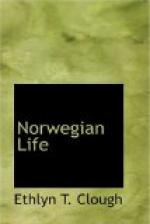The best art-made music of Norway has been built upon the folk-songs and dances of the common people. Halfdan Kjerulf (1815-1868) was the first serious composer of the new art school. He lived during the trying period of Norwegian storm and stress, but he wrote something like a hundred compositions, and in his songs is found “the bud of national feeling which has burst into full bloom in Grieg.”
Richard Nordraak (1842-1866), during his brief career, set to music several of Bjoernson’s plays, and composed some strong pianoforte pieces and songs. “He was,” says Siewers, “a man with a bold fresh way of looking at things, strong artistic interests, an untiring love of work, and deep national feeling. He had decided influence upon his friend Grieg’s artistic views, and he is the connecting link between Kjerulf and Grieg in the chain of Norwegian musical art.”
Otto Winter-Hjelm, who, with Grieg, attempted to establish a conservatory of music at Christiania after their return from Germany in the sixties, contributed much to the national art of Norway by his excellent arrangements of hallings and spring dances for piano and violin. Thomas Thellefsen (1823-1874), a pupil and friend of Chopin, was distinguished as a national composer as well as a pianist, and Carl F.E. Neupert (1842-1888), who lived in America six years, did much by his concert tours and teaching to dignify Norse music.
Johan Severin Svendsen, while a Norwegian by birth and training, has expatriated himself by his long residence in Denmark. So far as his compositions have national flavor they are German. Johan Selmer, while a prolific composer, will probably be best remembered as a conductor. Christian Sinding, after Grieg, is the best-known Norwegian composer. His productions range from symphonies and symphonic poems through chamber music to romances. He is credited with a wide range of musical ideas, deep artistic earnestness, and bold power of expression; but his compositions in the larger forms are thought unduly noisy and restless.
Two women who have helped to make the music history of Norway are Agatha Backer-Groendahl and Catharinus Elling. Mrs. Backer-Groendahl was a pupil, first of Kjerulf and Winter-Hjelm, and later of Kullak, Hans von Buelow, and Liszt. Many of her songs and instrumental pieces display fine artistic feeling and musical scholarship of no mean order. Catharinus Elling has ventured into the larger fields of music-forms, and has produced operas, symphonies, and oratorios, as well as chamber music and songs. Her music drama, “The Cossacks,” is her most ambitious work.
Says Henry T. Finck, an able American music critic: “When I had revelled in the music of Chopin and Wagner, Liszt and Franz, to the point of intoxication, I fancied that the last word had been said in harmony and melody; when lo! I came across the songs and piano pieces of Grieg, and once more found myself moved to tears of delight.” Edvard Grieg (1843-1907) undoubtedly occupies the foremost place among Norwegian composers. He is the highest representative of the Norse element in music, “the great beating heart of Norwegian musical art.”




